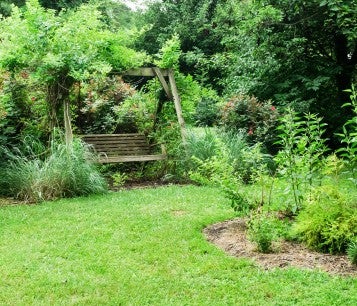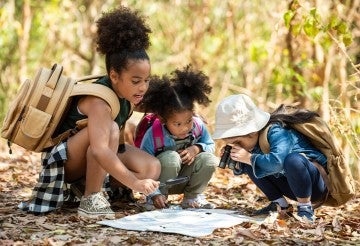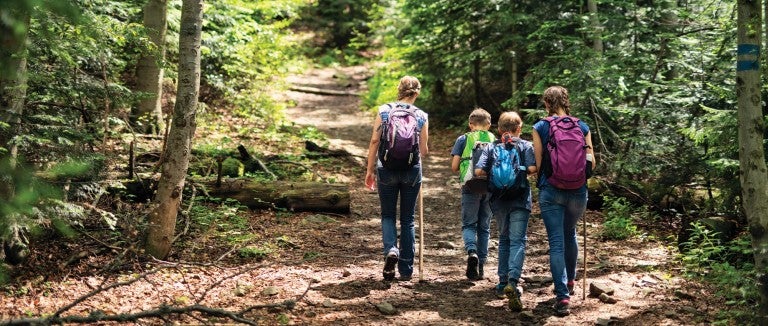We zigzag from tree to tree, seeking refuge under the leaf umbrellas. Drizzle turns to deluge as we dash beneath a tall canopy to plot our escape. The sky booms. My dad takes my hand, and I look up to see if he shares my sense of foreboding. But he’s smiling at me, his eyes twinkling. He says something funny, and we start laughing. I feel happy. Hand in hand, we make a break for it, dodging the downpour with the help of our tree friends, even though we’re already dripping wet.
This is my first memory of being alive, two months before my third birthday. Decades later, the rain-soaked hike remains foundational to my worldview. The trees took care of me on that day and many others, and so did my dad. It only makes sense that I have spent the rest of my life loving them back.
That’s not just my theory. Research correlates such childhood experiences and adult role models with lifelong respect for the natural world. While humans reap documented benefits from venturing beyond manmade environments—including stress reduction and greater physical health—our early interaction with nature is also essential to the survival of other species. As Richard Louv concluded in Last Child in the Woods, future decision makers are unlikely to protect what they don’t understand: “If we are going to save environmentalism and the environment, we must also save an endangered indicator species: the child in nature.”
Even the title of Louv’s book, which introduced the phrase “nature deficit disorder,” resonates with sustainability educator Chiara D’Amore. “I felt like the last child in the woods,” says the 36-year-old, who used to spend hours alone outside while her friends were glued to their video games. “That was me.”
A humane backyard is a natural habitat offering wildlife plenty of food, water and cover, plus a safe place to live free from pesticides, chemicals, free-roaming pets, inhumane practices and other threats. And it's so easy to build!

For her doctoral research on the positive influence of family nature clubs, D’Amore started a group in Maryland two years ago. Columbia Families in Nature has been transformative for participants, including the deaf girl whose newfound confidence on uphill hikes amazes her mother, the families walking in a river or meadow for the first time, the boy and his mom who “feel like a part of nature” now, stopping to help an injured bird they would have ignored in the past, they told D’Amore. “We can’t just walk by.”
Whether out of fear of the unknown or lack of knowledge, many parents are hesitant to head into the wild, says D’Amore. Clubs remove barriers through guidance, camaraderie and a feeling of safety. But you don’t need a formal group to give the gift of nature. If you’re hiking in a park, enhancing your yard or walking through your neighborhood, these tips can help engage the little ones in your life.
Nature knows best
It’s no surprise that shrinking wildlife habitat coincides with a dearth of kid-friendly spaces. Flat turfgrass provides few places to dig, hide or explore. What children gain in new ball fields, writes Louv, they lose in opportunities for self-directed play: “Research suggests that children, when left to their own devices, are drawn to the rough edges … the ravines and rocky inclines, the natural vegetation. ”
When designing such elements for natural play spaces, Julie Dieguez recalls favorite memories: the natural cave of a forsythia bush or the pine trees that sheltered her “Madam Zula” table, where she and her sister put half of a split-apart, star-speckled rubber ball on their heads and told fortunes to neighborhood kids. Such magical forts can also sprout from sunflower hedges and bamboo fences, says Dieguez, whose company, The Wild Child, helps organizations and families bring kids outdoors. “They are what you make them,” she says. “For us, it was usually a house, sometimes a hideout. But in all cases, it was a special place that was jufst ours.”
Wildlife-friendly plants add opportunity for discovery. Milkweed is the “crown jewel,” says Dieguez, who witnessed more than a dozen monarch chrysalises hatching while eating pancakes with her daughter in their backyard.
The simpler, the better
Kids are like cats: They just might snub expensive toys for cardboard boxes. Jumping in leaves, climbing rocks, making mudcakes, leaping across sliced tree stumps—this is the stuff their dreams are made of.
Scavenger hunts for skunk cabbage or signs of beaver chewing are a favorite activity, says D’Amore. Before group outings, she does a “pre-hike” to find logs harboring salamanders and other close-up opportunities. “You can’t orchestrate that,” she says, “but any time when I can help draw people’s attention to slowing down and looking and pausing and getting quiet, we come across a turtle or a frog or even a centipede or worm, and the kids just go gaga over it.”
You don’t need a naturalist’s knowledge to get started. “As adults, our default is that we think that something needs to be really intricate and complex to be interesting to a child, and that’s so not true at all,” says Dieguez. “In fact, in a lot of cases the more simple it is, the more they have to use their imagination.”
At autumn “leaf parties” D’Amore helps organize, families make pollinator gardens from cardboard and leaves laid over turfgrass. The goal is increased habitat connectivity, but the children’s main job is to jump in the piles. “It doesn’t take a whole lot of leaves and sticks to keep them happy,” says D’Amore. “At one of the last leaf parties … all my daughter wanted to do was play with the woolly bear caterpillars.”

As adults, our default is that we think that something needs to be really intricate and complex to be interesting to a child, and that’s so not true at all. In fact, in a lot of cases the more simple it is, the more they have to use their imagination.
Julie Dieguez, The Wild Child
Tap into your kid-brain
To learn respect for animals, it helps if you can relate to them. Nevada environmental educator Margie Klein uses her hands to model a stealthy coyote. “To survive in the environment, the coyote has to keep its ears open all the time but its mouth closed,” she tells her young charges. “Let’s be quiet coyotes.”
If kids chase animals or carelessly rip leaves off bushes, Klein asks, “What would it be like if this was your home?” To discourage them from collecting wildlife as pets, Klein asks illuminating questions. “Horned toads only eat a certain kind of ant. So I tell the kids,” she says, in an almost-whisper, “‘Do you think you could find enough of this one species of ant to keep it fed every day?’”
On desert walks near her home, Klein and her grandson look for tracks, nests and other signs of animals: Has anyone been bedding down in the bushes? Are there shallow scrapes where jackrabbits have slept? Who chews on leaves? Which seeds will birds eat?
Klein uses food to talk about scat; cocoa puffs represent plant-eater pellets, Tootsie Rolls mimic meat-eater scat. Fox scat looks like granola bars because foxes are omnivores. “You’ve got to find ways to connect it to a child’s mind and make it interesting for them.”
By letting kids lead the way in conversation and in the woods, you can avoid the feeling of “a forced march through a museum,” says D’Amore. “It’s that old adage: It’s about the journey.”
Long after my dad and I ran scattershot through the storm, I continued my nonlinear path. Sometimes the one-block walk from school took two hours, but my mom understood there were important discoveries to be made in the crackly leaves on the curbside or the water beneath the sewer grate. The world wasn’t a place to barrel through or admire from afar; it was a place to touch, smell, hear and be a part of—my place, and one that, all these years later, I would remain committed to protecting.
Want more content like this?
This was written and produced by the team behind All Animals, our award-winning magazine. Each issue is packed with inspiring stories about how we are changing the world for animals together.
Learn MoreSubscribe
